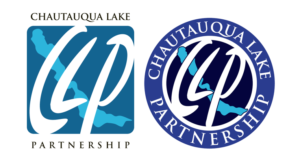Good evening all.
We hope you had an enjoyable Memorial Day weekend.
We had a very successful Chautauqua Lake Partnership (CLP) Rally Saturday morning with over 75 attendees. It was held in the upstairs hall at The Village Casino in Bemus Point where famous performers like Frank Sinatra, Benny Goodman and others entertained thousands in the early-mid 1900’s. A special thanks to The Village Casino for use of their facility and the homemade breakfast they provided for all who attended. Stop in to The Casino and check out their new menu.

As you can see, the Chautauqua Lake Partnership, now 147 strong, has adopted two logos. We will be using these logos for various things along with our slogan, “Chautauqua Lake, A Great Lake Seeking a Greater Future”. We have hats, t-shirts and koozies with the logos available for purchase. Contact Marcia Cirbus at jcclp@chautauqualakepartners.
Several of our state, county and municipal government representatives were introduced and voiced their support for CLP plans, including: Assemblyman Goodell, County Executive Horrigan, County Legislator Chagnon, Supervisor Johnson and Mayor Dahlberg. CLP “legacy” members, with experience from the very important early 2000 lake improvement efforts, were introduced to attendees by Karen Rine, former CLP President and current CLP Secretary. Dr. Jim Cirbus, CLP President, introduced CLP Officers Jim Wehrfritz (Vice President), Mike Latone (Treasurer), Karen Rine (Secretary) and new Board Members Jami Henderson and Jennifer Gibson.
Jim Cirbus provided an Overview of the CLP Mission and Organization (see attachment). Jim stressed that current approaches to weed management are not sufficient and new approaches must be tried.
Jim Wehrfritz began with a series of 6 “myths and truths” then provided an update on the 2017 Bemus Bay Weed Management Demonstration Project (see attachment 1 and 2). Jim described the preliminary results of last week’s Bemus Bay Weed Survey: Medium to Dense weeds, mostly invasive Curly Leaf Pondweed and Eurasian Milfoil, minimal native species/choked out by invasives, 2′ of decomposing weeds on the lake bottom. Jim described the broad participation in the CLP Project and provided a history of Chautauqua Lake herbicide use and permitting. A timeline of interactions with the NYS Department of Environmental Conservation (DEC) was shown highlighting 6 months of a challenging relationship.
The major permitting challenge is a 1986 agreement which set Chautauqua Lake herbicide permitting requirements in excess of those for other NYS lakes and water bodies. A three-pronged Plan Forward was described including an Emergency Authorization given the early, dense and almost exclusively invasive weed growth in Bemus Bay, pursuit of a narrowed-scope Town/Village permit application and, if necessary, challenge of the 1986 agreement which is at the root of Chautauqua Lake herbicide permitting problems. Given the early/dense weeds, obvious on the Bay this weekend, 2017 is expected to be an especially bad year for weeds and associated problems if a herbicide treatment is not allowed.[Note: there would likely be no Pondweed or Milfoil in the Bay if the proposed early May herbicide treatment had been done.]
Mike Latone provided an update on the Shoreline/Near Shore Cleanup Demonstration Project. It’s hoped that the operation can be mobilized by early July. There’s a possibility of an interim operation as well.
Jim Cirbus stressed the need for several methods of weed management in Chautauqua Lake including herbicides and weed cutting/harvesting. Jim suggested that weed cutting impacts would be identified and mitigated if permits were required for weed cutting as they are for herbicides. A summary of impacts and a graphic comparison of on-bottom weed deposition (see attachment) was presented showing that optimal herbicide use would drastically decrease deposition of seasonal weed die-off and fragments falling to and decomposing on the lake bottom. These decomposing weeds, ~2 feet thick in Bemus Bay according to last week’s survey, release nutrients to the water and feed weed and algae growth as well as making boat anchoring difficult.
Sara DeMink, Fundraising Chairperson, told us that $45,000 had been raised in individual donations since fundraising began 2 months ago, well on the way to the goal (see attachment). Sara’s Committee will focus in the near term on businesses who depend on the lake.
The Rally concluded with the reading of the attached poem authored by Tom Erlandson, PhD, a former Professor of Biology at Jamestown Community College and active lecturer and field guide.
As Tom says, “…please join us, we need you, we really do…”. Join CLP, donate to our cause if able and contact your state and county representatives and ask them to show their support of CLP plans.
Chautauqua Lake Partnership Officers and Board Members